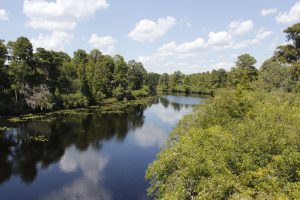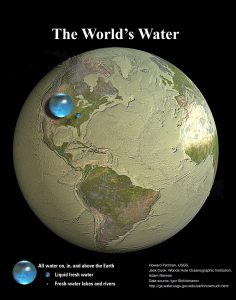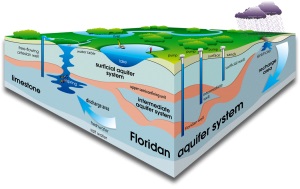Water as a Limited Resource

If you happen to be anything like me, you have gone most of your life wondering where our water comes from without getting any straight answers from the people you’ve asked. It can be frustrating to not know how such an important system operates and what we can do as a society to protect and sustain our water resources.
Now is the time to become literate in the world of water conservation, especially with a rapidly growing population in Florida and recurring drought. Thankfully, if you happen to be here reading this, you will not only learn about the source of our water but how we can help conserve it for future generations.
Surface Water Sources
Water covers over 71% of our Earth, so there must be plenty of water to drink and use, right? Not quite! While you may or may not be a stranger to how our potable water (or water that is safe to drink) gets processed, it is important to note that most of the water that we drink and use in our homes comes from predominantly freshwater sources. So, just how much freshwater is available? To put it in perspective, here is a graphic from the United States Geological Survey.

As you can see, there is a very small pool of surface water such as freshwater lakes and rivers that we can use for our potable water. These bodies of water are also home to many fish, birds, and other wildlife that make our state beautiful and biodiverse.
Since we are only able to get a percentage of our water from lakes, rivers, and springs, we should consider some of the other sources we can use.
Florida Aquifers
Outside of its use in direct applications, water also has great use stored underground as…you guessed it, groundwater! More than 90 percent of Floridians rely on Florida groundwater for some portion of their water supply.

Florida groundwater comes from aquifers, or underground rocks and sand that hold water. Our frequent withdrawals of water have significantly lowered the levels of freshwater stored in our underground aquifers, putting a strain on our environment and utilities. By making a conscious effort to conserve, we can help relieve that strain and work toward positive change.
Florida Laws Created to Protect Our Water Supply
Florida law requires the Florida Department of Environmental Protection or the Florida Water Management Districts to regulate how much water we can take for our potable needs from these natural surface water features and our underground aquifers without posing significant harm to the environment. The two laws that are used to regulate how much water we can take are (1) consumptive use permits (CUPs) and (2) minimum flows and levels (MFLs).
CUPs allow their holders to take only a certain amount of water from reserves. The water must be used with good reason, such as for drinking water or irrigation purposes. Water drawn from these sources must be used conservatively to be in compliance with the permit. To make sure this happens, environmental scientists collect and analyze data from pumped water regularly.
MFLs, on the other hand, are put in place to keep freshwater systems from being heavily withdrawn. A minimum amount of water is needed in these systems to keep them functioning and healthy, so these permits help ensure that happens. Moving bodies of water (like rivers and streams) are monitored to determine minimum flows, while water bodies that stay still (such as aquifers and lakes) are monitored to determine minimum levels. If these levels or flows are expected to be lower than the minimum, the District works on a recovery or prevention strategy.
For more information on the importance of water conservation (as well as some great tools to help you calculate your water use), please visit our website at http://sfyl.ifas.ufl.edu/sarasota/natural-resources/water-resources/water-conservation/
Check back soon to learn about some effective water conservation strategies!
An Equal Opportunity Institution. UF/IFAS Extension, University of Florida, Institute of Food and Agricultural Sciences, Nick T. Place, dean for UF/IFAS Extension. Single copies of UF/IFAS Extension publications (excluding 4-H and youth publications) are available free to Florida residents from county UF/IFAS Extension offices. Sarasota County prohibits discrimination in all services, programs or activities. View the complete policy at www.scgov.net/ADA.
 0
0
